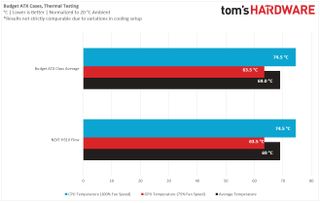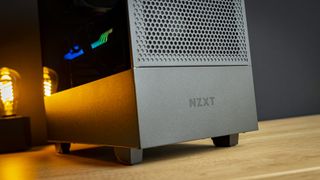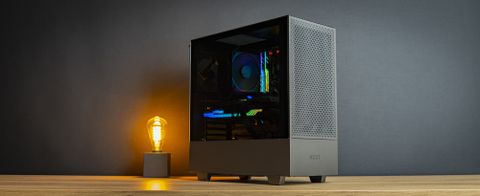Why you can trust Tom's Hardware
Fan Characteristics
The two fans included with the H510 Flow are non-RGB, 120mm spinners that don’t have PWM support. Their maximum speed is limited to about 1250 RPM, which isn’t high, but does offer the benefit of nice, quiet performance. In my testing, they ran at a minimum speed of about 550 RPM, which created a tiny bit of motor noise at idle operation – but too little to pick up with the dB meter above the noise floor.
Acoustic Results
For the acoustic tests, I run three scenarios in our new testing methodology, with the aim of giving you an idea of realistic noise levels. The first is an optimized idle with all the fans spinning at the lowest possible speed and the GPU on its fan-stop mode. Next is a test with the case fans at maximum speed to showcase their noise level only, and then I add the CPU and GPU to the mix with the quiet Noctua cooler at 100% and the GPU at 65% fan speed – a level at which it often runs.

For acoustics, the case’s fans can run quietly enough to match our test room’s noise floor for measurement, though I can hear them at idle. At full speed, they’re not loud at all at just 38.8 dBA. The case doesn’t keep a lot of noise in either with the mesh front, but that’s to be expected. With mild fans like these, this case will reward you accordingly if you buy a quiet CPU cooler and GPU.
Thermal Results
For thermal results, I use different settings. All fans are set to their maximum speed, and the RTX 3080 Ti GPU is raised to 75% fan speed -- this is to ensure it can always meet its power target so that its power consumption doesn’t affect the results. The CPU, meanwhile, is pinned at an overclock of 4.0 GHz at 1.2 V, also so that its power consumption is consistent and thermal tests are comparable between different cases and in different ambient temperatures.

As this is the first system I’ve tested with this new ATX setup, I can’t say much about comparative thermals. The numbers look quite reasonable though, and in a test without the fan speeds and overclocks pinned to gather this data, the CPU and GPU showed healthy boost behavior.
Conclusion

All things considered, the H510 Flow is a decent chassis. It feels a bit outdated by today’s standards, but the case builds well, and I quite like its style. And even though I don’t have testing data on this new ATX platform to compare it to yet, I can say that it performs well enough not to warrant serious complaints.
But, at this price the case really needs an extra USB 3.0 Type-A port. The finish quality on this sample was less than satisfactory. There are large panel gaps on the right panel, and there’s no support for a 240mm AIO at the top. Heck, the top fan mount isn’t even recessed to hide the screws you’ll need to mount a fan there. That’s so 2017.
And then there’s the issue of price, which certainly doesn’t help the case’s appeal.
If the H510 Flow would have carried the originally intended MSRP of $75, I’d more than happily recommend it. In fact, I might even contemplate it for our Best PC Cases list at that price. But at $110, I’m hard-pressed to recommend for most builders, unless it goes on sale.

Typically, NXZT’s MSRP prices sit quite close to the actual retail price, so I don’t doubt that when the company says the case is going to cost $110, that it will cost $110. The problem there is the competition. Last week, I reviewed the Lian Li O11 Air Mini – a case that also cost $110, but that comes with bits of aluminum for chic looks, a way nicer, more thought-out internal design, tons more radiator support, and three PWM fans. NZXT’s case only comes with two and they don’t do PWM.
Meanwhile, if you’re looking for a case with this more traditional form factor, there is Fractal Design’s Meshify 2 Compact – a case that also comes with three fans and much better internal design, better radiator support, and also costs – you guessed it – $110. Also consider the brilliant Corsair 4000D Airflow.
These are all much better cases that show what something great in the $110 (or $95 for Corsair’s case) price bracket gets you, clearly exhibiting added value.
Again, don’t get me wrong: The H510 Flow is a good chassis, but only at $75. I’d accept $85 in the current market, but few of the other case makers have raised their prices by more than $10 in this category. At $110, the H510 Flow just feels overpriced.
Niels Broekhuijsen is a Contributing Writer for Tom's Hardware US. He reviews cases, water cooling and pc builds.
-
NightHawkRMX NZXT must be off their rocker if they think they can charge nearly double just for drilling some holes in the front.Reply
Absurd. -
Phaaze88 So they fixed 1/2 of the problem with the original(restricted intake and exhaust)... that price can go fly a kite though.Reply -
Bubu93 To be fair but price seems quite decent (at least here in Italy) if it stays at the 109€ MSRP, it's actually the same MSRP as the normal H510...Reply
Pretty much all reputable brand cases with mesh intake (CM NR600, Corsair 4000D, Meshify 2, Phanteks P360A, Lian Li O11 Air mini etc ) hover around that value, they don't look as good imho (and probably not just for me considering the success of the 510 despite the horrible cooling performance) and many lack features like the USB-C port.
If you want something cheaper the only alternative here are poorly refined offbrand chassis which can cool just as well but lack QC and features.


